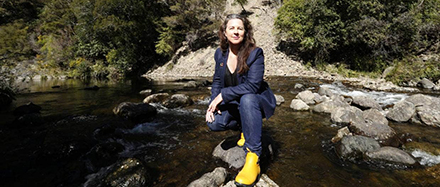There were hugs for Rachel Sanson after her successful bid to get all eligible council forestry registered for carbon trading. Initially, the council was assessing only its native forestry blocks, about 27 hectares’ worth of forestry, for registration in the Emissions Trading Scheme (ETS). Source: Stuff
Councillor Rachel Sanson put forward an alternative motion expanding the consideration to all council-owned land and requesting that eligible council-owned land be registered into the ETS.
Sanson said registering eligible land was a way to address the lack of financial benefit she perceived for ratepayers in the council’s commercial forestry ventures.
“The community is paying for a forestry operation that it has been gaining little financial benefit from. Here is a very low-risk opportunity to turn that around,” she said.
“This is a decision we need to make today, and this is a decision that preserves and amplifies our opportunities now and for future generations.”
The council heard from managing director of Carbon Forest Services Ollie Belton, who said the council stood to lose up to an estimated $1.8 million worth of credits if it did not register its commercial exotic forestry along with its indigenous blocks.
This was because the potentially eligible forestry under discussion had already sequestered four years’ worth of carbon, and by the deadline at the end of next year would have sequestered five years’ worth.
“If you do not join the ETS before the end of next year, then all the forests [under discussion] will become what we call ‘stranded carbon assets’ and will never be able to earn carbon credits again,” Benton said.
“By doing nothing you are losing an opportunity; by participating, worst-case you have some expenses but no risk, and best case you have options going forward.”
He said, should the council change its mind later, the cost to de-register blocks was too small to be meaningful – at a maximum estimate of a few thousand dollars.
The city council’s independent forestry expert, Peter Gorman, cautioned that registering commercial forestry blocks would not necessarily reap many financial benefits, depending on forest management, but said that there was not a significant risk.
He said the council had gone through this process before – first registering about 118 hectares of commercial blocks in the ETS in 2012, before deregistering in 2016 due to the minimal financial benefit.
Councillor Kate Fulton spoke in favour of the motion, saying that while the ETS was “somewhat confusing”, the registration was an opportunity for the council.
“I do think that this is an important part of walking the talk and showing the community that we are doing everything we can to participate in climate change responses.”
Councillor Tim Skinner spoke against the proposal because he was “a little bit cynical of a carbon credits system”, especially for a mature forest.
“My concern is with carbon credits we’re falsely justifying more resource use because we just justify it by the trees we’ve already got growing,” he said.
The vote was taken in parts.
The agreement to undertake a detailed assessment of all council land for eligibility in the ETS was passed 11 votes to one, with Skinner voting against.
The request for eligible council owned and managed land, including exotic forestry, to be registered in the ETS passed nine votes to three, with Skinner, Gaile Noonan, and Yvonne Bowater voting against.
Deputy mayor Judene Edgar was absent from the meeting.
Sanson was congratulated with hugs from councillors Pete Rainey, Kate Fulton, and Matt Lawrey.






